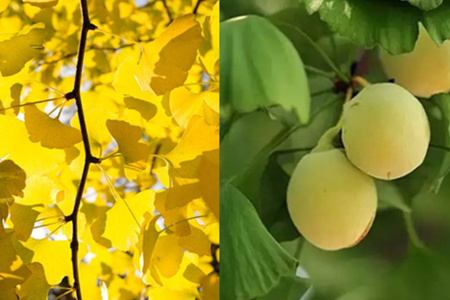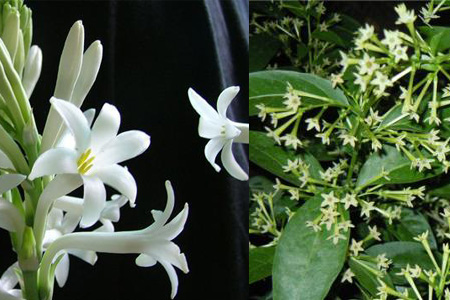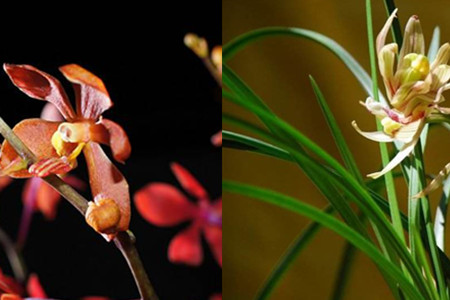What is the method of ginkgo seed propagation? these points should be paid attention to.

The sowing of ginkgo seeds is affected by time, place, climate and other factors, so it is necessary to master the correct method. The specific steps are as follows:
First, make a seedbed.
The quality of the seedbed directly determines the survival rate of seeds. Ginkgo likes to be waterlogged, so the seedbed must be chosen in a place rich in water. Loosen the soil, rake it flat and rake it fine, and then dig a small trench every 25cm or so.
Second, sowing seeds
Sow the seeds in the ditch. In order to promote the development of lateral roots, the outer shell of the seed can be broken in advance, but the germ inside must not be hurt. When covering the soil, do not be too deep or too shallow. Too deep will make the seeds germinate slowly, while too shallow will not help the seeds to absorb nutrients.
Third, raising seedlings
Covering the seedbed with a thin film can maintain the soil temperature and facilitate seed germination. When the new buds of the seeds penetrate the film, pay attention to pest control and weeding. At this time, weeds and pests in the field will damage the growing environment of the seedlings and damage the tender seedlings. Herbicides and insecticides can be used to spray the seedlings at this time.
Notes are as follows:
I. selection of seeds
In the past, most farmers would choose smaller seeds, because before 2000, ginkgo seeds were more expensive, and the smaller the seeds, the more the number per jin. But now the price of seeds is not very high, so we must choose larger particles, the seedlings cultivated by this kind of seeds are relatively strong and grow well.
Pay attention to fertilization
Ginkgo biloba seedlings have a great demand for fertilizer, so we must ensure the adequacy of fertilizer. The period from May to June belongs to the fast-growing period of seeds, at which time nitrogen fertilizer should be applied once. August belongs to the growing period, so you have to chase potash fertilizer once.
I hope everyone can learn the correct method of ginkgo seed propagation!
It is necessary for ginkgo biloba seed planting method to accelerate germination in advance.
Every year around November, the roads in some schools turn golden. Do you think the workers have painted them? No, it's because it's covered with a kind of leaf. Speaking of which, many friends should have been able to guess what this article is about, yes, ginkgo biloba. This kind of plant is quite common in our country, but in fact, it is also an ancient and rare tree species, and almost all we see are relatively "young" trees.
There are roughly three ways to reproduce this kind of tree, and here we are talking about using its seeds to reproduce. So, how exactly should it be operated?
1. About the selection of seeds
If you want to get a strong plant, you must first choose a good seed. When choosing seeds, friends must ask the age of their mother plant in advance, because if the tree does not grow long enough, its seeds will not be very healthy. In addition, we should also choose those who are fuller, because the seeds in this state are new.
2. The choice of time
For our country, before and after the Qingming Festival is a good time to grow this kind of plant. Or friends can also take a look at the ginkgo tree outside, if the tree has begun to sprout, then it can be planted.
3. Prepare for sprouting
Before officially planting, friends need to put the seeds on the sand and rest for a few days, of course, spray a little water on the sand, which is sprouting. If this step is not carried out, it will be very difficult for the seed to sprout.
4. VOD
Insert the treated seeds into the soil one by one, pay attention to exposing the buds, and wait for about two weeks.
Although the whole planting process is not easy, you don't have to take care of them after they are planted.
How to plant ginkgo seedlings? What should we pay attention to?
The crown of ginkgo biloba seedlings is shady and has the effect of cooling. It is an ideal cultivated tree species for greening, roadway, highway, nursery, field forest net, windbreak forest belt and greening of organs, schools and factories. The following is to introduce the relevant content of ginkgo seedlings.
Planting of Ginkgo biloba seedlings
1. Sowing and raising seedlings
Under the condition of seed propagation and natural growth, the dryness is very strong, the crown is high and the main branches are few; the seeds of artificially planted ginkgo trees should be harvested with large grains, and the mother trees about 80 years old are the best, and the seeds collected are peeled and dry. For early fruiting and convenient management, the trunk can be controlled not to be too high, but the branches can be expanded in all directions. The dry height is generally 1.0 to 1.5 meters, and the trunk is short, which is conducive to accelerating crown growth, early fruit and high yield, as well as management and harvest. Autumn sowing is available in the south and spring sowing is suitable in the north. The sandy loam with good water permeability should be selected in the seedling bed.
2. Breeding stage
In February and March, the sprouting shoots with roots on the basal half of the mother tree were dug up from the root tillers of the strong female trees in February and March, and planted in the nursery with a diameter of 1 cm to 4 cm. Before planting, the soil should be fertilized with basic fertilizer, and the depth of planting should be appropriate, not too deep and too shallow, and it should not be watered without excessive drought after transplanting. This method is easy to survive. It will blossom and bear fruit in about 10 years. It is propagated by sprouting tillers at the base of the trunk, and after grafting, it can bear fruit in 3-4 years, and the fruiting life can reach more than 3000 years at most.
3. Grafting propagation
The strong branches in the full fruit stage were used as scions and were grafted on the seedlings by splitting method. When using grafting propagation, different scions are used, which also have different effects on crown development and yield. Generally, 2-3 scions were grafted on one rootstock. After the scion survived, the backbone branches at the top of the scion grew strongly and could form 1-2 main branches, and then branches were produced on these main branches to form several branch groups that expanded outward, and then continued to branch and expanded into a crown. High trunk grafting has less basal branches, more apical branches and late fruit, while low trunk grafting has more branches at the base, rapid crown expansion, early fruit and high yield. The first grafted ginkgo tree has a large annual growth, which can reach more than 1.0 meters, and then gradually weakens.
4. Take root in the ground
From May to June, the cuttage seedlings were cut into 10 cm to 15 cm from the soft branches of the same year or from the fruiting trees, leaving 3 to 4 leaves on the top, and the lower incision was cut into a Maltese slope. After the base was immersed in water for 2 hours, the cuttings were cut on the vermiculite sand bed and intermittently sprayed with water to ensure that the leaves were not dry and could take root in about one and a half to two months.
5. Growth process
Seedlings transplant ginkgo biloba is a deep-rooted plant, growing for a long time, artificial planting, topography, topography, soil quality, climate should create good conditions for it. Choose high dry terrain, long sunshine, sufficient sunshine, deep soil layer, good drainage, loose and fertile loam, yellow pine soil, sandy soil, seedlings can be transplanted in spring and autumn every year. Among them, the acidic and neutral loam grows luxuriantly, grows well, and forms the forest ahead of time. Ginkgo biloba with a diameter of less than 5 cm can be planted with bare roots, and more than 6 cm generally need to be cultivated in soil. The seedlings planted with bare roots were in the slow seedling stage in that year. The seedlings with dirt can grow in that year. The seedlings were planted in rows and then irrigated with water. As for the planting of big trees, it is best to fill the pit with water before planting, and after the water in the pit has seeped, the big tree will be implanted into the pit to tamp, so that the water in the pit will come back to nourish the roots.
6. Management of seedlings
6.1 Ginkgo biloba trees like fertilizer, humidity and high aeration, so it is necessary to strengthen soil and water management after ginkgo planting. First, we should persist in deeply digging and loosening the soil every year, at least around the tree plate; second, we should apply more fertilizers, especially more organic manure, such as barnyard manure and rotten garbage; and third, we should pay attention to irrigation and drainage, and properly water in the dry season. stagnant water should be removed in time in the rainy season. Deep excavation of loose soil is usually carried out in autumn and winter. Ginkgo biloba root early, when the ground temperature rises to 6 degrees Celsius, the root system begins to move. To the south of the Yangtze River, deep digging had better be completed before February. The application of chemical fertilizer can be carried out all the year round, and the application of organic fertilizer should be dug up and buried shallowly on the soil surface from September to October, or combined with deep digging in winter.
The distance between plants in Ginkgo biloba fruit forest is large, so it is the most suitable for interplanting crops. It's just that in interplanting, we should pay attention to choosing good crops. Those who absorb too much fertilizer, especially those that can cause serious diseases and insect pests, or root exudates that hinder the growth of ginkgo biloba, it is best not to plant. Some crops, such as corn, absorb a lot of fertilizer, but it is related to the lives of local farmers, and they can also be interplanted, but more fertilizer must be applied when interplanting. Practice has proved that the root exudates of plants such as tobacco and walnut are extremely disadvantageous to the growth of ginkgo, while potatoes can induce a large number of harm to grubs, so it is better not to plant. The growth of ginkgo biloba can not be short of organic fertilizer. When soil organic matter is insufficient, it often induces serious nematode damage. It is difficult to transport in mountainous areas, and it is difficult to apply a large number of organic fertilizers that need to be transported. However, the planting of green manure should also be based on ensuring the normal growth of ginkgo biloba, and the green pressing at flowering stage should be adhered to in order to give full play to the fertilizer effect of green manure.
6.2 the annual growth of ginkgo biloba is relatively small, and it only shoots once a year under general management conditions. When the fertility is insufficient, the annual growth of branches is often less than 40 cm. The flower buds of ginkgo biloba are only formed in the short branches commonly known as bell branches. These two basic characteristics determine that ginkgo biloba is generally not pruned, or only for light pruning. However, because the grafted seedlings of Ginkgo biloba are often located at the edge of the crown, most of the grafted plants are often seriously partial to the crown, which will also affect the yield in the future. The way to correct the partial crown is to set up the pillar, hit the top properly (pick the heart), and apply more fertilizer at the same time. Generally speaking, as long as the terminal bud is cut off, several lateral buds in the lower part of the shoot can germinate, and several branches are formed in the first year or the second year, but the slow seedling stage is longer after ginkgo tree planting, and the partial crown is easy to be related to the deficiency of endogenous growth hormone. Ginkgo biloba seedlings with more organic fertilizer and well-developed root system basically have no slow seedling stage, and the partial crown can also be well controlled.
6.3 artificial pollination of ginkgo trees is the key technology to increase the yield of ginkgo biloba. Even if the ginkgo fruit forest is equipped with male pollination trees, artificial pollination should be carried out. There are many methods of artificial pollination, and the most practical way is to mix pollen into water and spray pollination. For the time of collecting male flowers, it is better for stamens to turn yellow. After picking the male flowers, spread them out to dry in time. Male flowers can sift out the pollen and dry it with quicklime. Such pollen can be kept at room temperature for more than 15 days. If kept dry and stored in the refrigerator, it can be stored for] years. If it is used for pollination within 10 days, do not screen out the pollen, just spread it out in a cool place. When in use, squeeze 1 kg of male flowers, add 30 kg of water, wash out the pollen, filter out the male flowers, and spray ginkgo trees as soon as possible.
Matters needing attention in planting Ginkgo biloba seedlings
Ginkgo trees avoid deep loading, and the depth of seedlings directly affects their future growth. Ginkgo biloba trees are sensitive to soil permeability and fertility, so their roots are mostly horizontally distributed on the surface of the stratum, even if they are breathing. it is also convenient for the absorption of nutrients and water, the new stem develops rapidly, and the seedlings grow vigorously. Once the seedlings are planted deeply, due to the poor permeability, the growth of the seedlings is slow or even stopped at low temperature. even if they are lucky to grow, the leaves, such as copper coins, cannot grow normally within 2-3 years, if the land is waterlogged. Hit the water. Will quickly lead to the death of seedlings. The suitable depth is the same as the original depth.
Pruning requirements of Ginkgo biloba seedlings
1. Crown pruning must retain the overall framework of the tree, remove dead branches, split branches, and bore branches.
two。 The top branches are pruned 75 degrees to prevent dust accumulation and germ reproduction.
3. The requirement of crown pruning varies according to different tree species, which is mainly based on the size of mud ball and the condition of mud ball root system.
4. Recuperate the worn roots and clean up the rotten roots.
Key points:
Master the principle of "no black spots and no rot in the whole section" when pruning.
The above is the relevant content about ginkgo seedlings, I hope it can be helpful to everyone!
- Prev

Can nocturnal incense be pruned and planted? learn to use this trick for a lifetime.
The spring of recovery of all things is coming, the season of willow branches and a hundred flowers blooming is not far away. Do you, who love flowers and plants, are eager to add some different elegant demeanor to your little garden? do you know how night incense is planted?
- Next

Introduction to the planting methods of night orchids there is an exquisite operation of dividing pots.
Night orchids are very different from ordinary orchids and are generally edible. Therefore, many people grow night orchids as ingredients for their own cooking. So how to grow such flowers? Let's take a look.
Related
- Fuxing push coffee new agricultural production and marketing class: lack of small-scale processing plants
- Jujube rice field leisure farm deep ploughing Yilan for five years to create a space for organic food and play
- Nongyu Farm-A trial of organic papaya for brave women with advanced technology
- Four points for attention in the prevention and control of diseases and insect pests of edible fungi
- How to add nutrient solution to Edible Fungi
- Is there any good way to control edible fungus mites?
- Open Inoculation Technology of Edible Fungi
- Is there any clever way to use fertilizer for edible fungus in winter?
- What agents are used to kill the pathogens of edible fungi in the mushroom shed?
- Rapid drying of Edible Fungi

